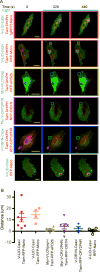Correlating in Vitro and in Vivo Activities of Light-Inducible Dimers: A Cellular Optogenetics Guide
- PMID: 26474029
- PMCID: PMC4766841
- DOI: 10.1021/acssynbio.5b00119
Correlating in Vitro and in Vivo Activities of Light-Inducible Dimers: A Cellular Optogenetics Guide
Abstract
Light-inducible dimers are powerful tools for cellular optogenetics, as they can be used to control the localization and activity of proteins with high spatial and temporal resolution. Despite the generality of the approach, application of light-inducible dimers is not always straightforward, as it is frequently necessary to test alternative dimer systems and fusion strategies before the desired biological activity is achieved. This process is further hindered by an incomplete understanding of the biophysical/biochemical mechanisms by which available dimers behave and how this correlates to in vivo function. To better inform the engineering process, we examined the biophysical and biochemical properties of three blue-light-inducible dimer variants (cryptochrome2 (CRY2)/CIB1, iLID/SspB, and LOVpep/ePDZb) and correlated these characteristics to in vivo colocalization and functional assays. We find that the switches vary dramatically in their dark and lit state binding affinities and that these affinities correlate with activity changes in a variety of in vivo assays, including transcription control, intracellular localization studies, and control of GTPase signaling. Additionally, for CRY2, we observe that light-induced changes in homo-oligomerization can have significant effects on activity that are sensitive to alternative fusion strategies.
Keywords: TULIP; cell signaling; cryptochrome2 (CRY2); dimerization; iLID; optogenetics.
Figures







References
-
- Boyden ES, Zhang F, Bamberg E, Nagel G, Deisseroth K. Millisecond-timescale, genetically targeted optical control of neural activity. Nat Neurosci. 2005;8:1263–8. - PubMed
-
- Shimizu-Sato S, Huq E, Tepperman JM, Quail PH. A light-switchable gene promoter system. Nat Biotechnol. 2002;20:1041–4. - PubMed
Publication types
MeSH terms
Substances
Grants and funding
LinkOut - more resources
Full Text Sources
Other Literature Sources
Research Materials

